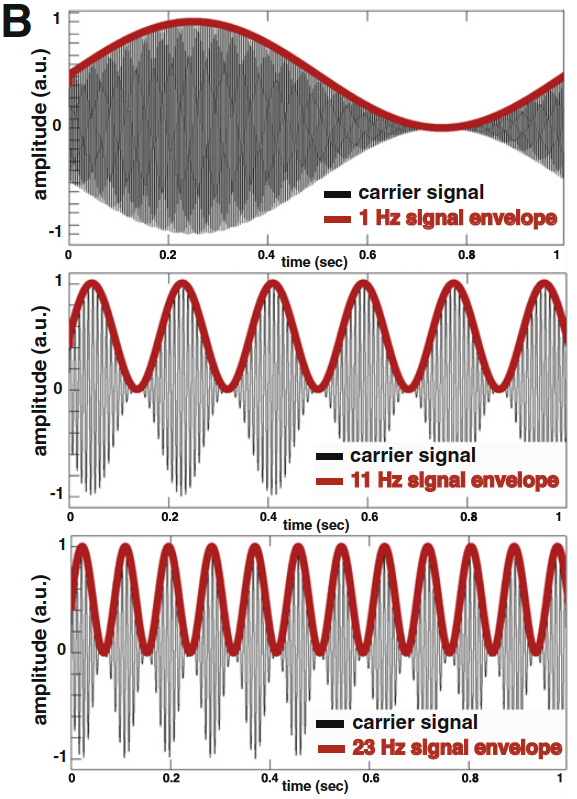Amplitude modulated Transcranial Direct Current Stimulation (AM-tACS)
Transcranial alternating current stimulation (tACS) can be used to causally manipulate brain physiology. Such effects are thought to be achieved by phase alignment of ongoing brain oscillations with externally applied electric currents (e.g. Polania et al., 2012). Classical tACS paradigms enable the frequency, amplitude and offset of a sinewave to be specified, which can be applied to the scalp as electrical stimulation. Amplitude modulated-tACS (AM-tACS) is new brain stimulation protocol that provides additional parameters of a sinewave that can be also used probe the causal relevance of brain oscillations to neural transmission and behaviour. The carrier frequency is similar to the sinewave used in classical tACS paradigms – the amplitude modulation feature enables the amplitude of the carrier frequency to change another frequency known as the envelope frequency. Simulations and experimental work have found that an envelope frequency can induce phase alignment between ongoing neural oscillations and the envelope frequency of tACS (Negahbani et al., 2018; Witkowski et al., 2016; Minami & Amano, 2017).
Image source: Witkowski et al (2016) Illustration of the stimulator output signal during amplitude modulated transcranial alternating current stimulation (tACS). Amplitude of a carrier signal (here a 220Hz signal) was modulated at 1Hz, 11Hz and 23Hz generating a signal envelope at the frequency of interest.
Evidence of amplitude modulation in neural processing has been found in the visual, somatosensory, and auditory domains (Lundstrom et al., 2010; Grosof et al., 1993; Mareschal & Baker, 1998; Giraud & Poeppel, 2012). AM-tACS can now be used as an additional protocol within the field of brain stimulation to probe the causal relevance of these neural oscillations to brain networks and behaviour. Recent work has revealed that the phase synchronization of envelope, but not carrier, frequencies modulate connectivity within resting state networks as measured by functional magnetic resonance imaging (Bachinger et al., 2017). Moreover, AM-tACS has also successfully been used to demonstrate the causal relevance of occipital-parietal peak alpha frequencies to variations in visual perception (Minami & Amano, 2017). The use of AM-tACS also provides an interesting avenue for future research. For example, it is unknown whether the effect of an envelope frequency on neural oscillations is affected the choice of carrier frequency (Witkowski et al., 2016).
In addition to providing an additional method of probing the causal relevance of brain oscillations, AM-tACS can also be used to reduce artefact beneath the site of stimulation during concurrent tACS-MEG. Such artefacts limit the ability of magnetoencephalography (MEG) to measure phase alignment between ongoing brain oscillations and tACS. These artefacts are present because the frequency of electrical stimulation during tACS, which is also measured by MEG, is often similar to the neural oscillatory frequency of interest to MEG measurements (Witkowski et al., 2016). However, published work has reduced artefact by using a carrier frequency that is greater than the frequency of interest and applying a lower frequency envelope similar to the oscillatory frequency of interest (Witkowski et al., 2016). This protocol produced artefact free measurements at a frequency of interest whilst simultaneously demonstrating entrainment or phase alignment of ongoing neural oscillations with externally applied AM-tACS (Witkowski et al., 2016; Negahbani et al., 2018).

